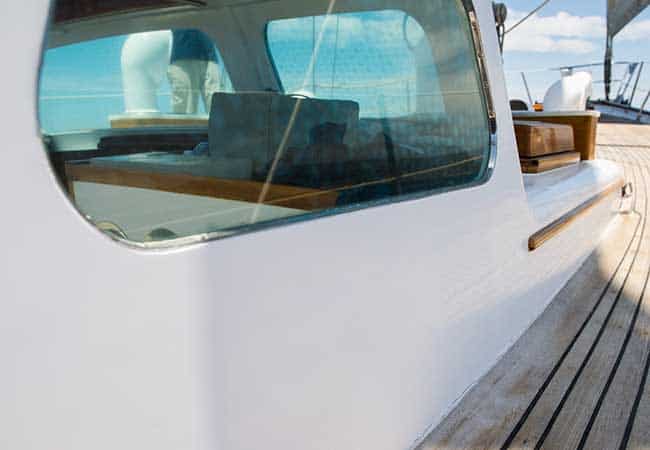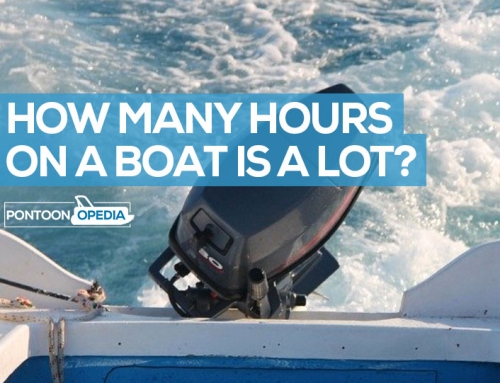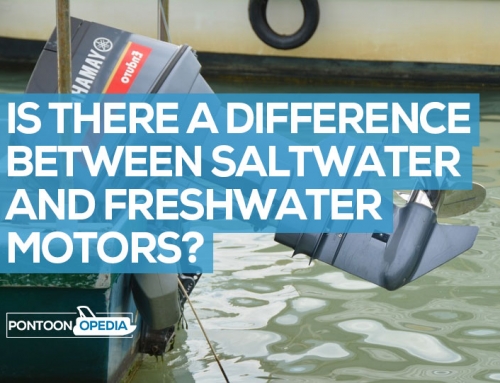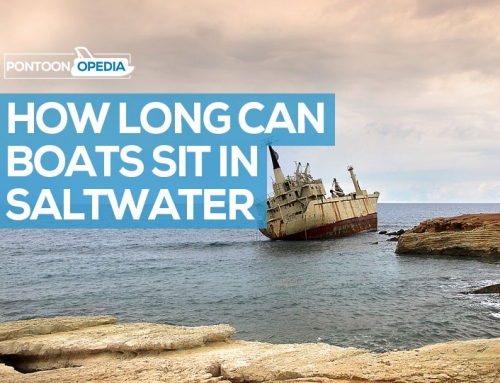One of the best aspects of owning a boat is being able to get out on the open water and enjoy the idyllic natural vistas. The beauty is shattered pretty quickly if you have a few dirty windows clouding up your view. Most boat windows are generally made out of a clear plastic like vinyl or acrylic, and they can get really dirty, yellowed, scratched and misted up.
Cleaning boat plastic windows isn’t as easy as glass, and they will need some extra care to avoid being scratched and damaged during the cleaning process.
Read on to find out how to clean boat plastic windows without scratching, including which chemicals to avoid and how best to maintain them afterwards so that they remain clean. I will also discuss methods to re-furbish your windows if they have become scratched and yellowed.
Table of Contents
How to clean boat plastic windows without scratching
Cleaning a plastic boat window is a relatively straightforward process but special care needs to be taken when cleaning. Plastic windows do not behave the same way as glass and can easily become scratched and damaged if you use the wrong products.
Follow the steps below to ensure that you do not damage the plastic, with the end result being spotless boat windows.
What you will need:
You will need a few basic supplies before getting started:
- 2 buckets (1 for the soapy water and 1 with clean water for rinsing)
- Microfiber cloths (view on Amazon)
- Vinyl window cleaner with UV protectant (view on Amazon)
- Polishing tools for tough scratches (view on Amazon)
1: Use the right type of soap that won’t scratch plastic
Vinyl is a plastic that is very sensitive to chemicals. It’s important to use cleaning products that don’t have any corrosive chemicals like ammonia, alcohol, bleach, solvents or petroleum products.
These can cause irreversible damage and the window will need to be replaced in most cases.
I recommend using a non-detergent soap. This is basically a soap that does not contain any synthetic compounds. These are the safest types of soap to use as they won’t react with the plastic and cause damage.
However, for best results you can get a marine cleaner that designed specifically for cleaning vinyl windows. It’s a great option if you want to play it safe and be absolutely sure that you don’t accidentally use a chemical that will damage and scratch the plastic windows.
These cleaners are usually referred to as protectants and cover the dual purpose of cleaning off any dirt and grime as well as applying a protective UV protectant coating to the window to prevent yellowing from UV damage.
Vinyl protectants can also work on acrylic windows.
2: Pre-clean the plastic boat windows with warm water
Start by rinsing your window down with some warm water. This will get most of the grime off before you start wiping it clean with a microfiber cloth.
If you start rubbing a cloth back and forth across the window and there is still a lot of dirt on it you can scratch the window very badly.
Handy Hint: A word of warning, we all love annihilating dirt with a pressure washer, but if you use a pressure washer on vinyl you will severely damage the plastic.
Once you have rinsed off the window a few times you can begin wiping off the dirt. The idea is to soften all the dirt so that it rinses off without having to vigorously scrub off all the dirt.
3: Clean the plastic boat windows
Once the plastic windows have been rinsed down and you have your cleaning solution ready you can apply it to the window.
Handy Hint: As an added precaution start on a small part of window first in case you make a mistake and scratch it.
To apply the cleaning solution to the windows you will need to use a microfiber cloth, dip it into your cleaning solution and then wring the cloth out again, wipe the window in left to right motions.
Do not double back on the same area when you wipe as you might track some dirt back across and scratch the surface of the window.
Rinse the cloth out again and repeat the above process until one side of the window is clean.
Then take another clean microfiber cloth and dip it onto a bucket of clean warm water and wipe the window off to remove any soap that may remain on the window.
Repeat the whole process on the other boat plastic windows.
Make sure that you use fresh soapy and clean water often especially if you are cleaning multiple windows.
4: Clean up any remaining water marks and streaks
If you find that there are still some water marks on the windows you can remove them with a 90/10 mixture of water and white vinegar.
Make sure you use another clean microfiber cloth to apply this solution, wiping it gently onto the water marks.
Maintaining your boat’s plastic windows
To make the cleaning process easier the next time around make sure you clean your windows regularly with a mild soap.
If you do this weekly you will won’t have to spend so much time cleaning in the future. As with the cleaning tips above, use a clean microfiber cloth each time as vinyl boat windows scratch very easily.
The cleaner and protectant mentioned earlier is a great product to apply every 4 to 6 weeks.
This will not just keep the window clean but also to protect the vinyl window from getting damaged by UV rays from the sun.
How to remove scratches from plastic boat windows
If you’ve followed all the above steps you should now have really clean plastic boat windows. You can sit back, relax and look at the sun set behind the distant horizon.
But, what if you now notice yellow markings and loads of tiny scratches on the window from days gone by?
If you followed the advice above then it won’t be your recent cleaning process that created the yellowing and scratches, but rather the general aging and wear and tear of the vinyl plastic.
The good news is that this is fixable too in some cases.
In order to protect your windows in future from yellowing, scratching and other types of events that do not fall under the dirty window bracket then the steps below can help you bring them back from the brink and looking (almost) brand spanking new.
What you will need:
The whole idea behind renovating your windows is to polish all the scratches out. So, you will need to get some polishing equipment if you don’t already have something.
The best thing to use is a small power polisher (view Amazon prices). These look like a standard grinder, but they have larger disks and places to put your hands that are ideal for polishing.
Get a few polishing pads as well, also note that vinyl requires a very fine polishing compound that can be found at most automotive shops.
I also recommend microfiber cloths as I recommended in the cleaning guide earlier.
1: Remove the scratched windows
You will need to remove the windows first as trying to polish them while they are attached to the boat will quite likely result in the window popping out of its mounts mid polish.

It’s a tough job, but it’s worth removing the windows before polishing out the scratches.
Once you have removed the windows, place them on a flat table that is covered with a clean towel.
You want a flat table because an uneven table can result in a cracked window once you put pressure on the window.
2: Polish the plastic boat windows
Once you are all set up you can begin polishing the window.
Use a clean lint free microfiber cloth to put polish on the window in an even coating.
You can then begin polishing the window by applying light pressure and keeping the pad moving across the surface. Make sure that the speed is between 1000 and 1200 rpm.
If your polisher is set too high you run the risk of adding too much heat into the plastic and then melting it.
Make sure that you always keep the pad moving, do not stay in the same place for too long.
3: Put the scratch-free windows back in
This process should remove a lot of the scratches from your boat’s plastic windows.
It might not get everything out, but they will look a lot better than they did before with most of the yellowing gone.
Once complete, pop the windows back in and you’re good to go.
Related questions
Below are some of the more commonly asked questions people ask in relation to “how to clean boat plastic windows”.
Why do vinyl windows go yellow?
Vinyl goes through a 3-step process when exposed continuously to the sun. First it becomes opaque, then it turns yellow and eventually it becomes brittle enough to crack and break at the slightest bump.
This is caused by the evaporation of plasticizers. This evaporation can be reduced by covering the vinyl whenever possible.
What are boat windows made of?
There are generally two types of clear plastic windows on boats; the windows are either made out of vinyl or acrylic whereas glass is extremely uncommon nowadays.
- Vinyl windows: also known as Eisen glass, is easily damaged by any detergent based chemicals and other solvents. It is also highly susceptible to damage from UV rays and eventually turns opaque, yellows and becomes brittle if continuously exposed to the sun.
- Acrylic windows: also known as Plexiglas or Luxite is similarly damaged by detergent based cleaners and solvents but is UV stable and is not as badly damaged by the sun
The last word…
Even the most expensive boats will use the same plastic, vinyl, PVC, clear acrylic, or polycarbonate windows. They are all prone to wear and tear, no matter how much money you spend on your boat.
The clear vinyl windows are the worst, as they can become yellow, brittle, and scratch very easily.
However, as long as the dirt hasn’t been left there for too long, you can rescue them if you act now and use a good plastic boat window cleaning routine as described above.
You should also be able to get rid of some of the smaller scratches with the method outlined in the second half of this article.









